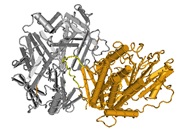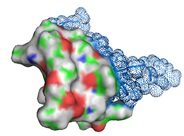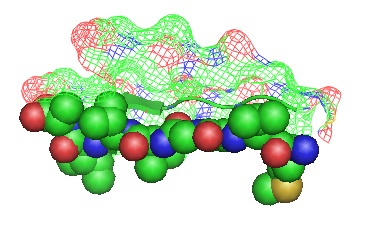|
|
|
Bio-Synthesis Newsletter - October 2020
|
Opposum Peptides Inhibit Toxins
 Currently, antivenom treatment is the only option to treat humans when bitten by toxic snakes, scorpions, spiders, ticks, or jellyfish. Bioactive small peptides function by binding to and inhibiting selected proteins with high specificity. The North American Opossum (Didelphis virginiana) can survive the venomous bite of the western diamondback rattlesnake (C. atrox). Peptides from the Lethal Toxin-Neutralizing Factor (LTNF), a protein purified from the opossum, can neutralize the venom in mice when a lethal dose of the poison is pre-incubated with the peptids followed by the intravenous injection. Lipps in 2000 showed that N-terminal peptides of LTNF, peptides LKAMDPTPPLWIKE and LKAMDPTPPL, inhibit rattlesnake toxin when given before and after a dose of the poison. These findings now may make it possible using synthetic peptides as potent antidotes for animal, plant, and bacterial toxins. Currently, antivenom treatment is the only option to treat humans when bitten by toxic snakes, scorpions, spiders, ticks, or jellyfish. Bioactive small peptides function by binding to and inhibiting selected proteins with high specificity. The North American Opossum (Didelphis virginiana) can survive the venomous bite of the western diamondback rattlesnake (C. atrox). Peptides from the Lethal Toxin-Neutralizing Factor (LTNF), a protein purified from the opossum, can neutralize the venom in mice when a lethal dose of the poison is pre-incubated with the peptids followed by the intravenous injection. Lipps in 2000 showed that N-terminal peptides of LTNF, peptides LKAMDPTPPLWIKE and LKAMDPTPPL, inhibit rattlesnake toxin when given before and after a dose of the poison. These findings now may make it possible using synthetic peptides as potent antidotes for animal, plant, and bacterial toxins.
|
|
Read More
|
|
|
The Renin-Angiotensin System
 The renin-angiotensin system (RAS) plays a central role in the regulation of blood pressure and volume homeostasis. Renin catalyzes the first step in the conversion of angiotensinogen to the hormone angiotensin II. Angiotensin peptides are candidates for the treatment of various physiological disorders. For example, angiotensin II is presently under investigation for the treatment of sepsis, septic shock, diabetes mellitus, and acute renal failure. Since December 21, 2017, angiotensin II is approved for intravenous infusion as a vasoconstrictor to increase blood pressure in adults with septic shock. Also, angiotensin 1-7 helps with the treatment of blood cell abnormalities. Many other renin inhibitors have been developed, but more research appears to be needed to investigate the function of RAS in various tissues, mainly how the system influences cancer cells. In addition, vitamin D also regulates of blood pressure through RAS. The renin-angiotensin system (RAS) plays a central role in the regulation of blood pressure and volume homeostasis. Renin catalyzes the first step in the conversion of angiotensinogen to the hormone angiotensin II. Angiotensin peptides are candidates for the treatment of various physiological disorders. For example, angiotensin II is presently under investigation for the treatment of sepsis, septic shock, diabetes mellitus, and acute renal failure. Since December 21, 2017, angiotensin II is approved for intravenous infusion as a vasoconstrictor to increase blood pressure in adults with septic shock. Also, angiotensin 1-7 helps with the treatment of blood cell abnormalities. Many other renin inhibitors have been developed, but more research appears to be needed to investigate the function of RAS in various tissues, mainly how the system influences cancer cells. In addition, vitamin D also regulates of blood pressure through RAS.
|
|
Read More
|
|
|
Peptides that protects against HIV or AIDS
 A natural peptide found in human blood called virus-inhibitory peptide (VIRIP) appears to protect against the infection of HIV. VIRIP binds to the spiky protein gp41 on the surface of the HIV virus. Muench et al. in 2007 reported that VIRIP (LEAIPMSIPPEVKFNKPFVF) corresponds to residues 353–372 of human α1-AT which is the most abundant circulating serine protease inhibitor in blood. Muench et al. found that the peptide inhibits a wide variety of HIV-1 strains. The researchers reasoned that these findings may lead to a new class of inhibitors that block the entry of HIV-1. Another example is enfurvitide, a 36 residue peptide, that inhibits HIV-1 fusion with CD4 cells (Ac-YTSLIHSLIEESQNQQEKNEQELLELDKWASLWNWF-NH2). Other HIV inhibiting peptides are under investigation for the development of a vaccine against AIDS. The database HIPdb (crdd.osdd.net/servers/hipdb/), is a manually curated database containing a list of validated HIV inhibitory peptides. A natural peptide found in human blood called virus-inhibitory peptide (VIRIP) appears to protect against the infection of HIV. VIRIP binds to the spiky protein gp41 on the surface of the HIV virus. Muench et al. in 2007 reported that VIRIP (LEAIPMSIPPEVKFNKPFVF) corresponds to residues 353–372 of human α1-AT which is the most abundant circulating serine protease inhibitor in blood. Muench et al. found that the peptide inhibits a wide variety of HIV-1 strains. The researchers reasoned that these findings may lead to a new class of inhibitors that block the entry of HIV-1. Another example is enfurvitide, a 36 residue peptide, that inhibits HIV-1 fusion with CD4 cells (Ac-YTSLIHSLIEESQNQQEKNEQELLELDKWASLWNWF-NH2). Other HIV inhibiting peptides are under investigation for the development of a vaccine against AIDS. The database HIPdb (crdd.osdd.net/servers/hipdb/), is a manually curated database containing a list of validated HIV inhibitory peptides.
|
|
Read More
|
|
|
Amyloid-β-peptides and Dementia
 Patients who have Alzheimer's disease, dementia with Lewy bodies (DLB), and Parkinson's disease dementia (PDD) mainly contain amyloid plaques which are carboxy-terminally elongated forms of amyloid-β (Aβ) peptides. The levels of the peptide Aβ1–42 in the cerebrospinal fluid have shown diagnostic value for the diagnosis of Alzheimer's disease and could be reliable biomarkers to diagnose these diseases. A study performed in 2006 by Bibl et al. indicated that disease-specific variations of the Aβ peptide patterns in CSF might allow significant discrimination of dementia subtypes and hopefully also allow for earlier diagnosis of these diseases. Patients who have Alzheimer's disease, dementia with Lewy bodies (DLB), and Parkinson's disease dementia (PDD) mainly contain amyloid plaques which are carboxy-terminally elongated forms of amyloid-β (Aβ) peptides. The levels of the peptide Aβ1–42 in the cerebrospinal fluid have shown diagnostic value for the diagnosis of Alzheimer's disease and could be reliable biomarkers to diagnose these diseases. A study performed in 2006 by Bibl et al. indicated that disease-specific variations of the Aβ peptide patterns in CSF might allow significant discrimination of dementia subtypes and hopefully also allow for earlier diagnosis of these diseases.
|
|
Read More
|
|
|
|
|
Bio-Synthesis, Inc.
800 Mario Court, Lewisville, TX 75057, USA
Toll Free: 800.227.0627 | 1.972.420.8505 (Intl.)
|
|
|
|
|
|